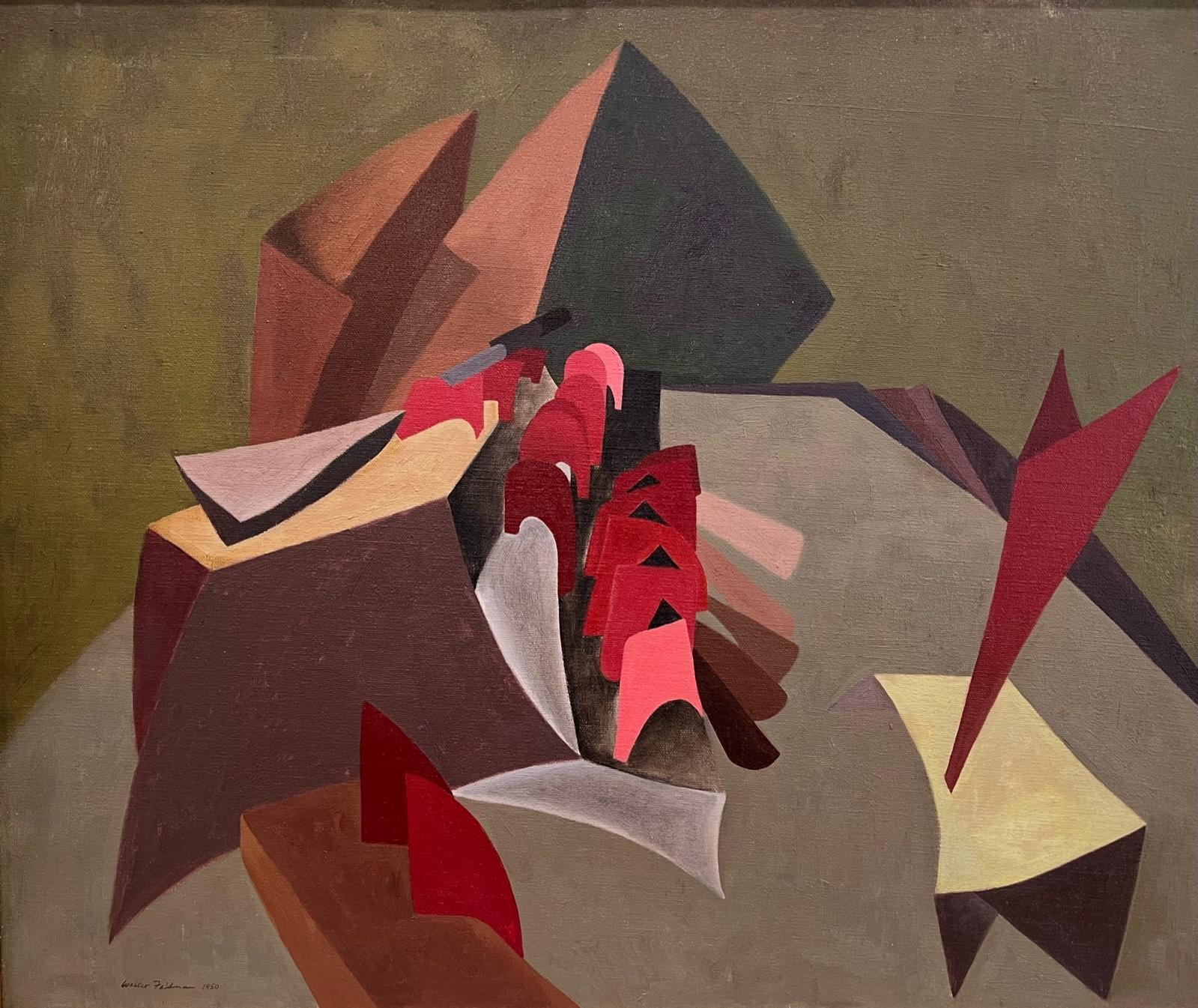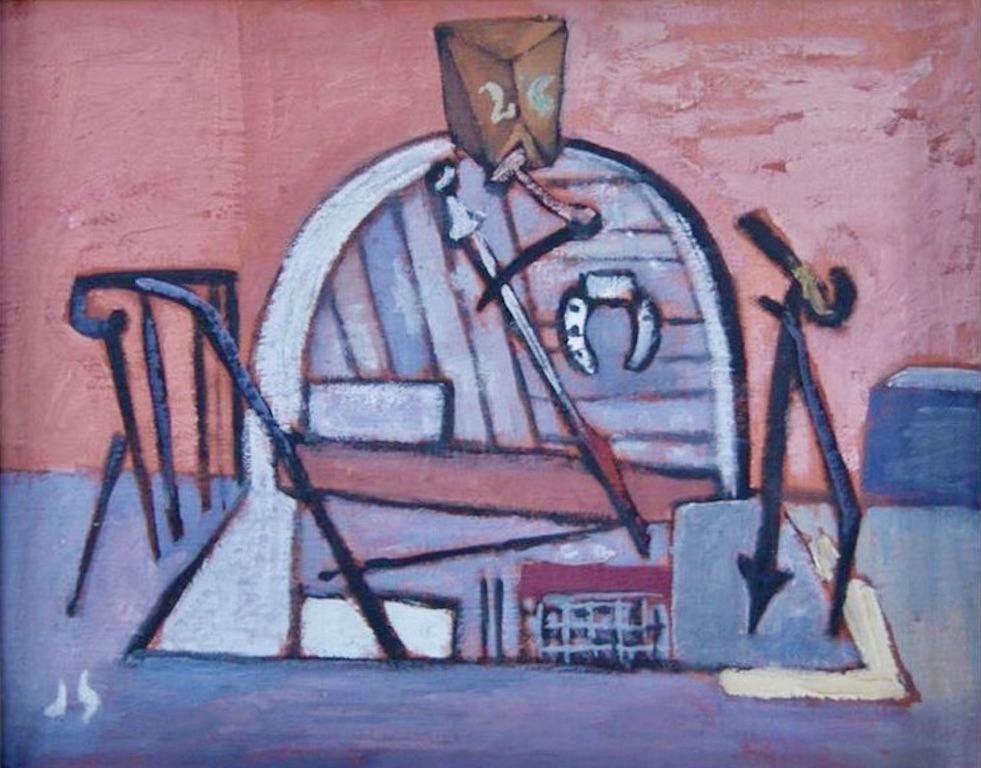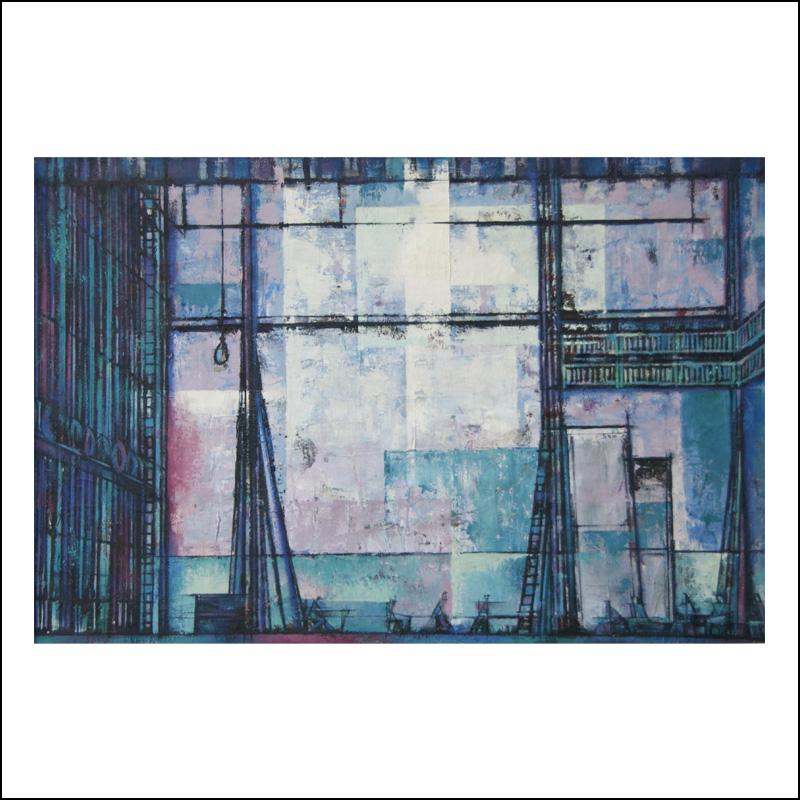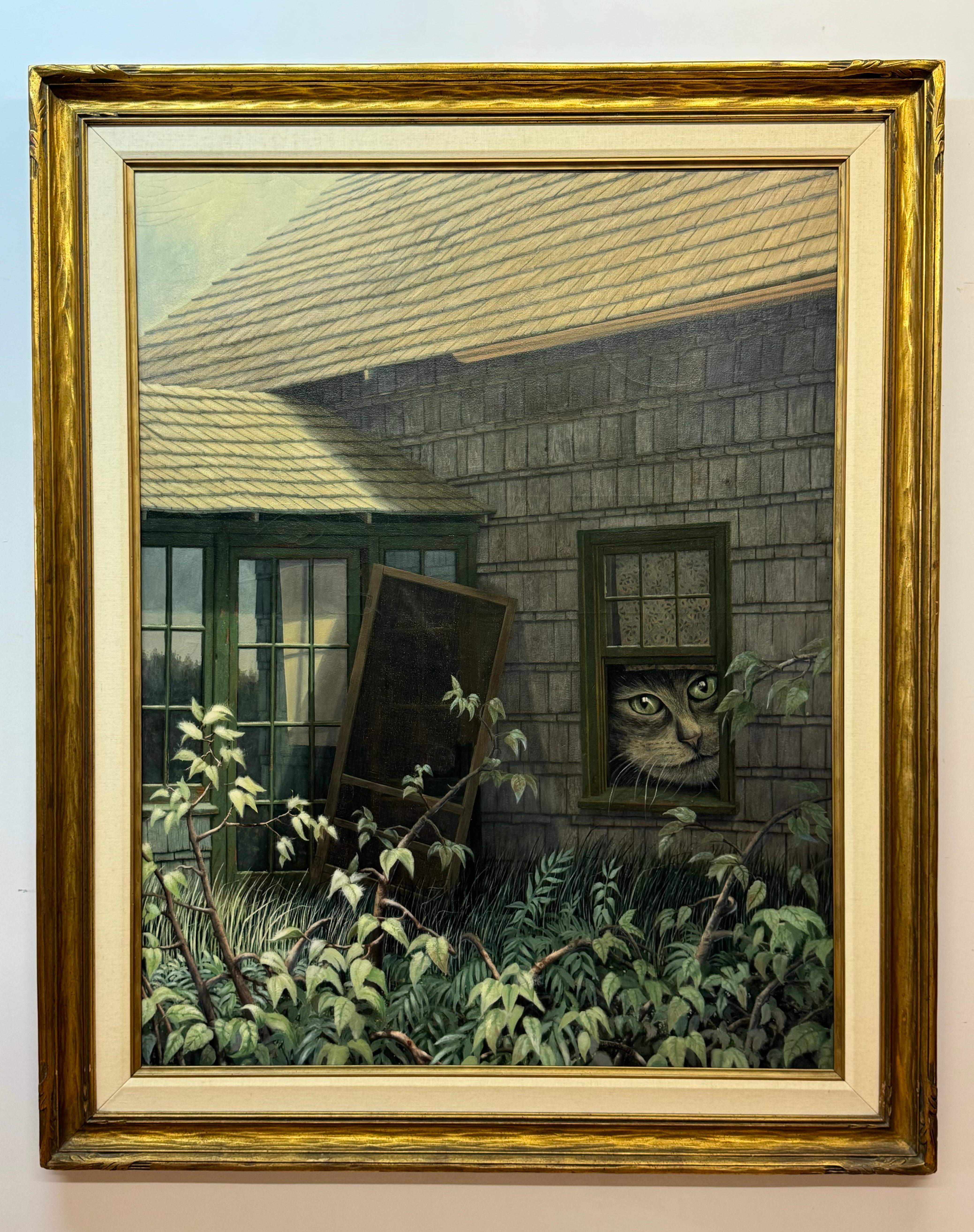Items Similar to Untitled
Want more images or videos?
Request additional images or videos from the seller
1 of 8
Louisa ChaseUntitled1985
1985
About the Item
Louisa Lizbeth Chase was born in 1951 to Benjamin and Wilda Stengel Chase in Panama City, Panama, where her father, a West Point graduate, was stationed. The family moved to Pennsylvania in 1958. Chase attended the George School, a private Quaker-sponsored boarding school in Bucks County. Initially intending to study classics at Syracuse University, she discovered printmaking and graduated with a Bachelors in Fine Arts in 1973. A Yale summer program confirmed her direction and she enrolled at the Yale University School of Art, earning her Masters in Fine Arts (MFA) degree in 1975. It was clear, early on, that Louisa Chase was special. In her final year in graduate school, she was selected for a solo show of “floor pieces” at the Artists Space, a non-profit gallery dedicated to showcasing emerging talent, located on Wooster Street in the heart of Soho, Manhattan’s burgeoning artist neighborhood. Degree in hand, Chase moved to downtown Manhattan, and became a part of the vibrant downtown art scene of the late 1970s and 1980s. As a young artist, Chase did what other young artists do. She taught—commuting to the Rhode Island School of Design in Providence from 1975 to 1979, and closer to home at the School of Visual Arts in Manhattan, from 1980 to 1982. In her downtown studio, she painted, made prints, and explored woodblock. As she worked, she garnered a series of solo shows and participated in a host of group exhibitions highlighting contemporary artists, including Barbara Rose’s 1979 manifesto at the Grey Art Gallery, New York University, “American Painting: The Eighties;” the Whitney Museum Biennial in 1982; and the American group contribution to the Venice Biennale in 1984. Chase’s work attracted serious, positive, and respectful notice in the art press, including, among many others, The Village Voice (Kim Levin, “The Secret Life of Louisa Chase,” Jan. 28, 1981), The New York Times (‘Louisa Chase,” February 17, 1989), and Arts Magazine (Richard Kalina “Louisa Chase,” May 1989, p. 90). Throughout her career, Chase remained a questing spirit, freely experimenting with various media. Similarly, her oeuvre reveals a variety of approaches at different times, so that, despite having attracted a number of labels, among them “new image school,” and “neo expressionist,” there is not one distinctive “Chase style.” Her credited influences range from the medieval Italian Sienna painters through Jackson Pollack. What never wavered was the artist’s intention to make visual on canvas her inner emotional state. In 1979, Chase wrote “painting for me is a constant search to hold a feeling tangible” (as quoted by Alexandra Anderson-Spivy in Finding a New Language: Louisa Chase’s Recent Paintings, exhib. cat. Foundation Kajikawa, Kyoto, Japan, 1991, p. 6). For a 1982 group show at the Whitney Museum, Chase wrote that “The forces closest to landscape are the closest to the internal forces that I am trying to understand. . . . The location is inside.” Chase’s work is represented in the permanent collections of a number of noted museums—the Whitney Museum of Art in New York; the Museum of Modern Art, New York (MOMA); the Metropolitan Museum of Art, New York; The National Gallery of Art, Washington, D.C.; the Brooklyn Museum; The Walker Art Center, Minneapolis, Minnesota; the Albright-Knox Art Gallery, Buffalo, New York; the Baltimore Museum of Art; the Butler Institute of American Art, Youngstown, Ohio; and the Nelson-Atkins Museum of Art, Kansas City, Missouri. In 1991, Chase moved to Sag Harbor, on the eastern end of Long Island, and then to nearby East Hampton where she bought a small 1930 farmhouse with a separate studio. As with lower Manhattan, Chase chose a location with an art community that was congenial and collegial. She was living in East Hampton when she died in 2016 after a seven-year-long struggle with cancer.
- Creator:Louisa Chase (1951 - 2016, American)
- Creation Year:1985
- Dimensions:Height: 18 in (45.72 cm)Width: 20 in (50.8 cm)
- Medium:
- Movement & Style:
- Period:
- Condition:
- Gallery Location:New York, NY
- Reference Number:
About the Seller
5.0
Recognized Seller
These prestigious sellers are industry leaders and represent the highest echelon for item quality and design.
Established in 1952
1stDibs seller since 2010
32 sales on 1stDibs
Typical response time: 12 hours
Associations
Art Dealers Association of America
- ShippingRetrieving quote...Ships From: New York, NY
- Return PolicyThis item cannot be returned.
More From This SellerView All
- No. 3 -1960By Stanley TwardowiczLocated in New York, NYSigned (on stretcher): Stanley Twardowicz Stanley Twardowicz (1917–2008), a one-time orphan, Golden Gloves boxer, professional baseball player and auto worker, emerged from a hards...Category
Late 20th Century American Modern Abstract Paintings
MaterialsEnamel
- Yours TrulyBy Arthur DoveLocated in New York, NYYours Truly is a work of 1927, a fertile year for Dove, capped by a solo exhibit at Stieglitz’s “The Intimate Gallery,” which included this picture. From 1924 through 1930, Dove produced a notable series of collages, interspersed with drawings, pastels, and oil paintings on a variety of supports. In 1927, the same year that Dove painted Yours Truly, he found inspiration in American popular music, often referring in his titles to works by George Gershwin and Irving Berlin. Yours Truly was the title of a Broadway musical that opened at the Shubert Theater on January 25, 1927. Gene Buck, the producer, had collaborated with Raymond Hubbell, the composer, on the Ziegfield Follies shows of 1923, 1924, and 1925. The production, which contained the title song, “Yours Truly,” ran for 127 performances, closing on May 14, 1927. Given the context of Dove paintings...Category
1920s American Modern Paintings
MaterialsOil, Canvas
- UntitledBy Louisa ChaseLocated in New York, NYLouisa Lizbeth Chase was born in 1951 to Benjamin and Wilda Stengel Chase in Panama City, Panama, where her father, a West Point graduate, was stationed. The family moved to Pennsylv...Category
20th Century American Modern Abstract Paintings
MaterialsCanvas, Wax, Oil
- UntitledBy Louisa ChaseLocated in New York, NYLouisa Lizbeth Chase was born in 1951 to Benjamin and Wilda Stengel Chase in Panama City, Panama, where her father, a West Point graduate, was stationed. The family moved to Pennsylv...Category
20th Century American Modern Abstract Paintings
MaterialsCanvas, Oil
- Nowhere, Now HereBy Louisa ChaseLocated in New York, NYLouisa Lizbeth Chase was born in 1951 to Benjamin and Wilda Stengel Chase in Panama City, Panama, where her father, a West Point graduate, was stationed. The family moved to Pennsylv...Category
1980s American Modern Abstract Paintings
MaterialsCanvas, Wax, Oil
- Sunset GripBy Louisa ChaseLocated in New York, NYLouisa Lizbeth Chase was born in 1951 to Benjamin and Wilda Stengel Chase in Panama City, Panama, where her father, a West Point graduate, was stationed. The family moved to Pennsylv...Category
20th Century American Modern Abstract Paintings
MaterialsCanvas, Wax, Oil
You May Also Like
- The OrchestraLocated in Los Angeles, CAThe Orchestra, 1950, oil on canvas, 21 ½ x 25 3/4 inches, signed and dated lower left, labeled verso “Brown University, Trustee, The Walter Feldman Trus...Category
Mid-20th Century American Modern Abstract Paintings
MaterialsCanvas, Oil
- Amish Farmscape #3By Edmund LewandowskiLocated in Los Angeles, CAAmish Farmscape #3, 1984, oil on canvas, 40 x 30 inches, signed and dated lower right; signed, dated, and titled verso About the Painting Amish Farmscape #3 is part of a multi-painting series of barns completed in the early 1980s for an exhibition at New York’s prestigious Sid Deutsch Gallery. Lewandowski painted this work at an important point in his career. It was the first major project undertaken by Lewandowski after his retirement from serving as the Chairman of Winthrop University’s Art Department, the last academic position he held after teaching for nearly thirty years. Lewandowski had been inspired to work on the series by a visit to Lancaster County, Pennsylvania. Like his friend and mentor, Charles Sheeler, Lewandowski had always been fascinated by vernacular architecture and the Amish barns of Pennsylvania brought back memories of rural scenes Lewandowski had painted in the Midwest much earlier in his career. Amish Farmscape #3 is a strong example of Lewandowski’s late precisionist work. The complexity of the composition and Lewandowski’s technical acumen are on full display. Being relieved of the burdens of teaching and administering a university art department likely allowed Lewandowski greater freedom and most importantly more time to complete the Amish Farmscape series. Although Lewandowski’s brand of precisionism changed throughout the years, he never deviated from the core tenets of the Immaculate School artists. In this work, we see simplified and flattened forms, the use of ray-lines to define light and space, the elimination of extraneous details, a polished almost machine-like finish, and the complete lack of visible brushstrokes, all hallmarks of the precisionist painters. Lewandowski was the last of the 20th century precisionists and in Amish Farmscape #3, we see just how successfully he continued to work in this style until his death in 1998. About the Artist Edmund Lewandowski was among the best of the second-generation precisionist painters. He was born and raised in Milwaukee, Wisconsin and studied at the Layton School of Art with Garrett Sinclair. Lewandowski achieved early success when in 1936 two of his watercolors were shown at the Phillips Collection as part of a Federal Art Project exhibition. Then, in 1937, his work was first exhibited at Edith Halpert’s Downtown Gallery which represented Lewandowski into the 1950s. Under Halpert’s guidance, Lewandowski continued to explore watercolor as his main medium during the 1930s and 1940s, since the gallery already represented Charles Sheeler, who worked primarily in oils. Sheeler became Lewandowski’s major influence as the primary leader of the ill-defined, but very recognizable Immaculate School artists, which included other Downtown Gallery painters, Niles Spencer, George Ault, and Ralston Crawford, as well as Charles Demuth and Preston Dickinson, both of whom died at a young age and had been represented by the Charles Daniel Gallery. Sheeler is credited with giving Lewandowski technical advice on how to make his paintings more precise and tightly rendered and by all accounts, Sheeler was a fan of Lewandowski’s work. Through the Downtown Gallery, Lewandowski’s paintings were accepted into major national and international exhibitions and purchased by significant museums and collectors. Franklin and Eleanor Roosevelt and Nelson Rockefeller acquired works by Lewandowski. He was included in the Museum of Modern Art’s important 1943 exhibition, American Realists and Magic Realists as well as juried exhibitions at the Whitney Museum of American Art, the Pennsylvania Academy of Fine Arts, and the Art Institute of Chicago. Lewandowski also completed commissions for magazines during the 1940s and 1950s, including several covers for Fortune. Throughout his career, Lewandowski explored urban and rural architecture, industry, machinery, and nautical themes. Looking back on his career, Lewandowski wrote, “My overwhelming desire as an artist through the years has been to record the beauty of man-made objects and energy of American industry on canvas. For as far back as I can recall, the cityscapes, farms and depictions of industrial power and technological efficiency has had a great attraction for me. I try to treat these observations with personal honesty and distill these impressions to a visual order.” Lewandowski is credited with extending precisionism to the Midwest and successfully continuing the style into the 1990s, three decades after Sheeler’s death and six decades after Demuth’s passing. Late in his career, Lewandowski enjoyed a resurgence of popularity as he was represented during the 1980s by New York’s Sid Deutsch and Allison Galleries...Category
Mid-20th Century American Modern Landscape Paintings
MaterialsCanvas, Oil
- WPA American Scene Modernism 20th Century NYC Industrial "Cellar with Horseshoe"By Joseph SolmanLocated in New York, NY"Cellar with Horseshoe" WPA American Scene Modernism 20th Century NYC Industrial Joseph Solman (1909-2008) "Cellar with Horseshoe," 16 x 20 inches, oil on canvas circa 1938, initial...Category
1930s American Modern Landscape Paintings
MaterialsCanvas, Oil
- "Backstage, Ambassador" Broadway Theatre NYC Mid-century Modern Modernist CubistBy Sam NorkinLocated in New York, NY"Backstage, Ambassador" Broadway Theatre NYC Mid-century Modern Modernist CubistSigned lower left, titled on the stretcher. Norkin was a Brooklyn, Ne...Category
1940s American Modern Interior Paintings
MaterialsCanvas, Oil
- "Shattered" WPA Mid 20th Century Modernism American Scene Surrealism FigurativeBy Leon BibelLocated in New York, NY"Shattered" WPA Mid 20th Century Modernism American Scene Surrealism Figurative Estate stamp on the stretcher, verso. Provenance: Estate of the artist. 20 x 24 inches. BIO Leon Bibel continued painting through 1941 and resumed work in both painting and especially wood sculpture by 1960. He worked until his very last day in 1995. His last series of large wood sculptures were modeled on spice boxes, which were miniature buildings...Category
1930s American Modern Figurative Paintings
MaterialsCanvas, Oil
- R. Hoag “Large Cat Peering Out Window”Located in San Francisco, CAOil on canvas 1979 Large cat peering out window Framed 45.25x55.5 Unframed 36x47Category
1960s American Modern Abstract Paintings
MaterialsCanvas, Oil
Recently Viewed
View AllMore Ways To Browse
Chase Contemporary
1985 Dior
Paintings By Chase
Modern Chase
Medieval Italian
Chase Long
American School Baltimore
Moma Modern Abstract Painting
Panama City
American Farmhouse Painting
Untitled 1991 Vintage
Untitled Vintage 1991
Painting East End Long Island
Vintage Farmhouse Painting
Anderson Abstract Oil Painting
Japanese Woodblock Abstract
Vintage Japanese Cat
Jackson Pollack Abstract Painting




